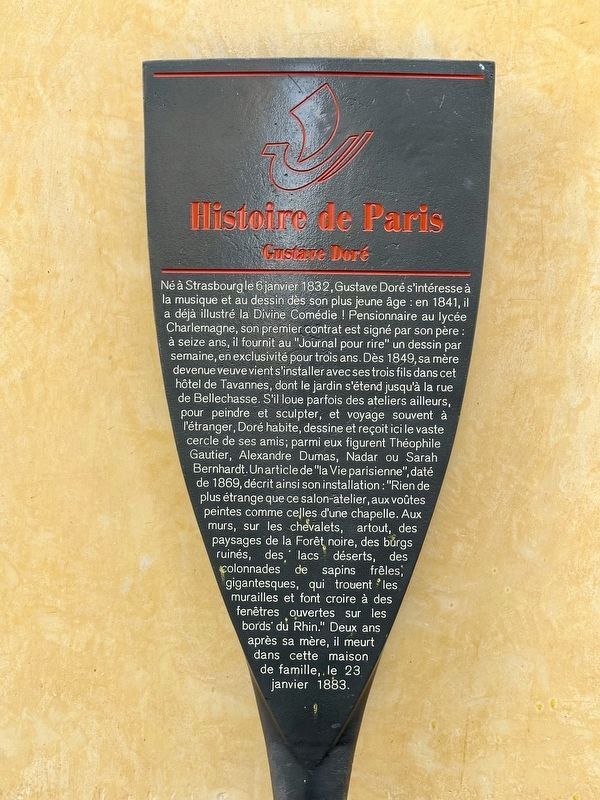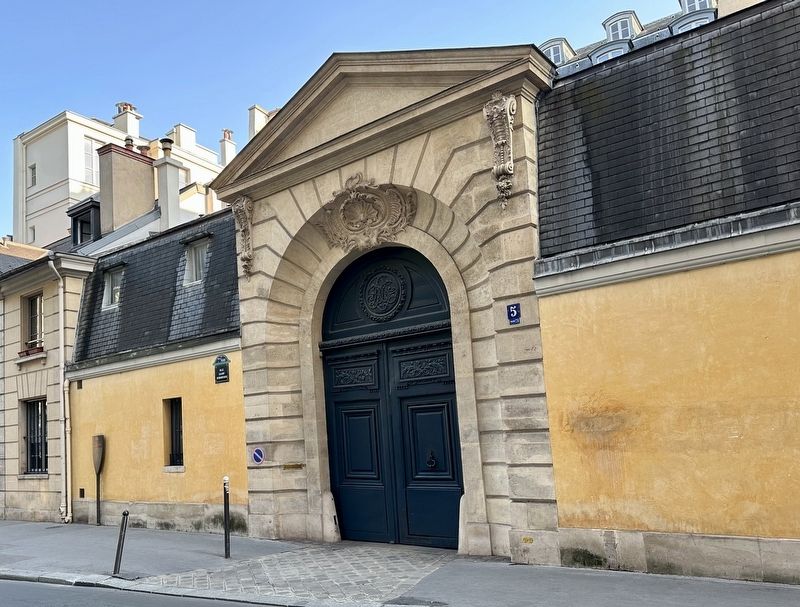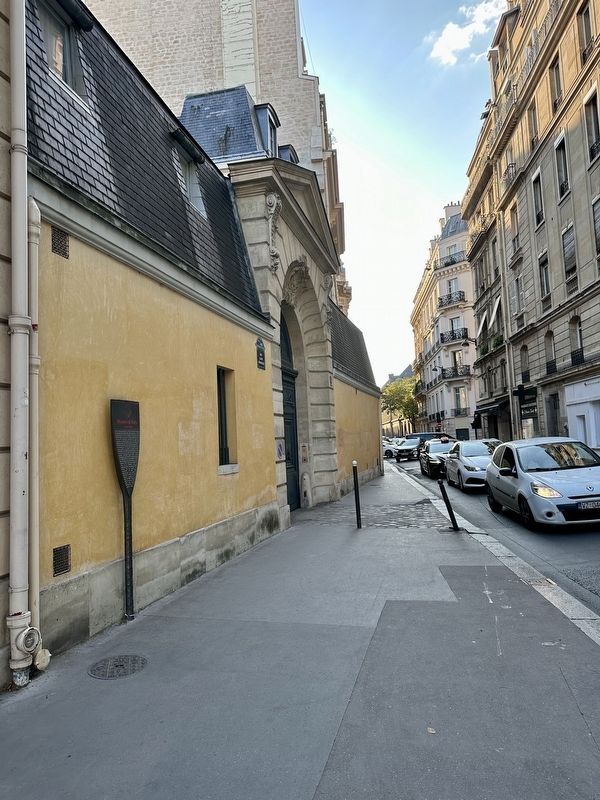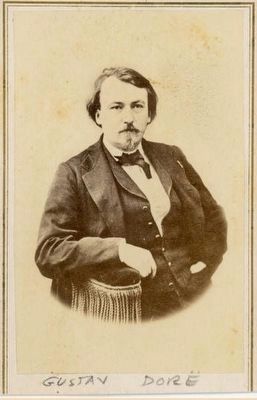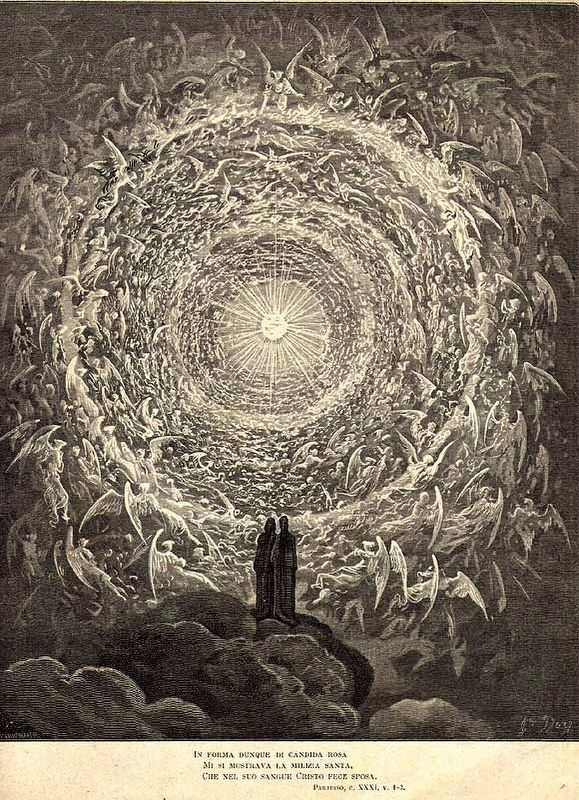Saint-Thomas-d'Aquin in Paris in Département de Paris, Île-de-France, France — Western Europe
Gustave Doré
— Histoire de Paris —
Né à Strasbourgle 6 janvier 1832, Gustave Doré s'intéresse à la musique et au dessin dès son plus jeune âge: en 1841, il a déjà illustré la Divine Comédie! Pensionnaire au lycée Charlemagne, son premier contrat est signé par son père: à seize ans, il fournit au "Journal pour rire" un dessin par semaine, en exclusivité pour trois ans. Dès 1849, sa mère devenue veuve vient s'installer avec ses trois fils dans cet hôtel de Tavannes, dont le jardin s'étend jusqu'à la rue de Bellechasse. S'il loue parfois des ateliers ailleurs, pour peindre et sculpter, et voyage souvent à l'étranger, Doré habite, dessine et reçoit ici le vaste cercle de ses amis; parmi eux figurent Théophile Gautier, Alexandre Dumas, Nadar ou Sarah Bernhardt. Un article de "la Vie parisienne", daté de 1869, décrit ainsi son installation: "Rien de plus étrange que ce salon-atelier, aux voûtes peintes comme celles d'une chapelle. Aux murs, sur les chevalets, artout, des paysages de la Forêt noire, des burgs ruinés, des lacs déserts, des colonnades de sapins frêles, gigantesques, qui trouent les murailles et font croire à des fenêtres ouvertes sur les bords du Rhin." Deux ans après sa mère, il meurt dans cette maison de famille, le 23 janvier 1883.
Born in Strasbourg on January 6, 1832, Gustave Doré was interested in music and drawing from an early age: by 1841, he had already illustrated the Divine Comedy! While a boarding student at the Lycée Charlemagne, his first contract was signed by his father: at sixteen, he was to provide the Journal pour rire (a humor magazine) with a weekly drawing, exclusively for three years. As early as 1849, his widowed mother came to settle with her three sons in this Hotel de Tavannes, whose garden extended to the street of Bellechasse. At times he rented workshops elsewhere, to paint and to sculpt, and often traveled abroad - there Doré lived, drew and received his vast circle of friends; among them are Théophile Gautier, Alexandre Dumas, Nadar or Sarah Bernhardt. An article from la Vie parisienne (“The Parisian Life”), dating from 1869, described his set up thusly: "Nothing is stranger than this salon-studio, with vaulted ceilings painted like those of a chapel. On the walls, on the easels, everywhere - Black Forest landscapes, castle ruins, deserted lakes, colonnades of frail pines, gigantic, going through the walls and with windows appearing to open up onto the banks of the Rhine." Two years after his mother, he died in this family home on January 23, 1883.
Topics and series. This historical marker is listed in this topic list: Arts, Letters, Music. In addition, it is included in the Histoire de Paris series list. A significant historical date for this entry is January 23, 1883.
Location. 48° 51.474′ N, 2° 19.396′ E. Marker is in Paris, Île-de-France, in Département de Paris. It is in Saint-Thomas-d'Aquin. Marker is at the intersection of Rue Saint-Dominique and Boulevard Saint-Germain, on the right when traveling east on Rue Saint-Dominique. Touch for map. Marker is at or near this postal address: 5 Rue Saint-Dominique, Paris, Île-de-France 75007, France. Touch for directions.
Other nearby markers. At least 8 other markers are within walking distance of this marker. Jean-Baptiste Dumas (a few steps from this marker); Jean-Martin Charcot (within shouting distance of this marker); La Banque de l’Algerie / The Bank of Algeria (within shouting distance of this marker); L’Alliance Française (about 120 meters away, measured in a direct line); Jean Vandal and Michel Belloc Memorial (approx. 0.3 kilometers away); Annette Kolb (approx. 0.3 kilometers away); Centre français de rapatriement (approx. 0.4 kilometers away); Pierre Janet (1859-1947) (approx. 0.4 kilometers away). Touch for a list and map of all markers in Paris.
Also see . . . Gustavo Doré (Wikipedia).
Overview: Paul Gustave Louis Christophe Doré (6 January 1832 – 23 January 1883) was a French artist, as a printmaker, illustrator, painter, comics artist, caricaturist, and sculptor. He is best known for his prolific output of wood-engravings, especially those illustrating classic books, including 241 wood-engravings that illustrate scenes from the Bible. These achieved great international success, and he is the best-known artist in this printmaking technique, although his role was normally as the designer only; at the height of his career some 40 block-cutters were employed to cut his drawings onto the wooden printing blocks, usually also signing the image.(Submitted on July 28, 2023.)
In all he created some 10,000 illustrations, the most important of which were "duplicated in electrotype shells that were printed ... on cylinder presses", allowing very large print runs as steel engravings, "hypnotizing the widest public ever captured by a major illustrator", and being published simultaneously in many countries…
Credits. This page was last revised on July 28, 2023. It was originally submitted on July 28, 2023, by Andrew Ruppenstein of Lamorinda, California. This page has been viewed 44 times since then and 11 times this year. Photos: 1, 2, 3, 4, 5. submitted on July 28, 2023, by Andrew Ruppenstein of Lamorinda, California.
